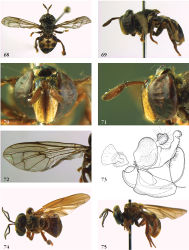Domodon
| Notice: | This page is derived from the original publication listed below, whose author(s) should always be credited. Further contributors may edit and improve the content of this page and, consequently, need to be credited as well (see page history). Any assessment of factual correctness requires a careful review of the original article as well as of subsequent contributions.
If you are uncertain whether your planned contribution is correct or not, we suggest that you use the associated discussion page instead of editing the page directly. This page should be cited as follows (rationale):
Citation formats to copy and paste
BibTeX: @article{Reemer2013ZooKeys288, RIS/ Endnote: TY - JOUR Wikipedia/ Citizendium: <ref name="Reemer2013ZooKeys288">{{Citation See also the citation download page at the journal. |
Ordo: Diptera
Familia: Syrphidae
Name
Domodon Reemer gen. n. – Wikispecies link – ZooBank link – Pensoft Profile
Type species:
Domodon zodiacus Reemer spec. n. Type locality: Surinam, Paramaribo.
Description
Body length: 6–8 mm. Moderately small flies with short antennae and oval abdomen. Head a little wider than thorax. Face convex; about as wide as or narrower than an eye. Lateral oral margins weakly produced. Vertex convexly produced, more or less shining, sparsely pilose, almost bare on anterior half. Occiput ventrally narrow, dorsally widened. Eye bare. Eye margins in male weakly converging at level of frons, with mutual distance 3-5 times width of antennal fossa. Antennal fossa about as wide as high. Antenna longer than distance between antennal fossa and anterior oral margin; basoflagellomere as long as or longer than scape, bare. Postpronotum pilose. Scutellum semicircular; with calcars. Anepisternum sulcate; pilose anterodorsally and posteriorly, widely bare in between. Anepimeron entirely pilose. Katepimeron almost flat to convex; often with wrinkled texture; bare. Wing: vein R4+5 with posterior appendix; vein M1 perpendicular to vein R4+5; postero-apical corner of cell r4+5 rectangular, with small appendix; crossvein r-m located between basal 1/6 to 1/4 of cell dm. Abdomen oval, about 1.5 to 2 times as long as wide. Tergites 3 and 4 fused. Sternite 1 bare. Male genitalia: phallus furcate near apex, with dorsal process long and whip-like, ventral process very short; epandrium with ventrolateral ridge.
Diagnosis
. Vertex convexly produced. Abdomen oval. Vein R4+5 with posterior appendix. Tergites 3 and 4 fused. Membrane between sternites 2 and 3 much less wide than sternite 2.
Discussion
All species assigned to this genus were previously undescribed or are still undescribed.
The phylogenetic analysis based on morphology places the type species (Domodon zodiacus sp. n.) in the same clade as Omegasyrphus Giglio-Tos, 1891, Pseudomicrodon Hull, 1937 and Rhopalosyrphus Giglio-Tos, 1891 (Reemer and Ståhls in press[1]). In addition to this phylogenetic evidence, the male genitalia of these taxa are all similar in the structure of the phallus and the shape of the surstylus. Because of the oval, non-constricted abdomen, Domodon species superficially may seem most similar to Omegasyrphus, but differ from that genus by the convex and sparsely pilose vertex, the long antenna, and the medially widely bare anepisternum. With Pseudomicrodon it shares the convex and sparsely pilose vertex, as well as the structure of the male genitalia, but Domodon differs from that genus by the oval (instead of constricted) abdomen.Instead of arbitrarily assigning the species in question to one of the mentioned genera, it is here considered preferable to erect a new genus, so as to emphasize the distinctive features of this group.
Diversity and distribution
Described species: 1. Surinam. Four additional, undescribed species are known by the first author from French Guyana, Surinam and Costa Rica. Probably the group is widespread in Central and South America.
Etymology
The generic name is a combination of domus and odon, with the latter used as a suffix derived from Microdon. The Latin word domus is here used in the meaning of ‘dome’ and refers to the convex (dome-shaped) vertex of the species in this genus. The name is to be treated as masculine.
Original Description
- Reemer, M; Ståhls, G; 2013: Generic revision and species classification of the Microdontinae (Diptera, Syrphidae) ZooKeys, 288: 1-213. doi
Other References
- ↑ Reemer M, Ståhls G (in press) Phylogenetic relationships of Microdontinae (Diptera: Syrphidae) based on parsimony analyses of combined molecular and morphological characters. Systematic Entomology 38.
Images
|
